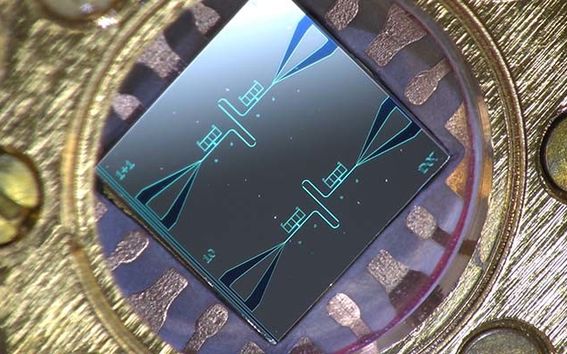Refrigerator for quantum computers discovered

The global race towards a functioning quantum computer is on. With future quantum computers, we will be able to solve previously impossible problems and develop, for example, complex medicines, fertilizers, or artificial intelligence.
The research results published today in the scientific journal, Nature Communications, suggest how harmful errors in quantum computing can be removed. This is a new twist towards a functioning quantum computer.
Even a quantum computer needs cooling fins
How quantum computers differ from the computers that we use is that instead of computing using normal bits, they use quantum bits, or qubits. The bits being crunched in your laptop are either zeros or ones, whereas a qubit can exist simultaneously in both states. This versatility of qubits is a needed for complex computing, but it also makes them sensitive to external perturbations.
Just like ordinary processors, a quantum computer also needs a cooling mechanism. In the future, thousands or even millions of logical qubits may be simultaneously used in computation, and in order to obtain the correct result, every qubit has to be reset in the beginning of the computation. If the qubits are too hot, they cannot be initialized because they are switching between different states too much. This is the problem Mikko Möttönen and his group have developed a solution to.
A refrigerator makes quantum devices more reliable
The nanoscale refrigerator developed by the research group at Aalto University solves a massive challenge: with its help, most electrical quantum devices can be initialized quickly. The devices thus become more powerful and reliable.
“I have worked on this gadget for five years and it finally works!” rejoices Kuan Yen Tan, who works as a postdoctoral researcher in Möttönen’s group.
Tan cooled down a qubit-like superconducting resonator utilizing the tunnelling of single electrons through a two-nanometer-thick insulator. He gave the electrons slightly too little energy from an external voltage source than what is needed for direct tunnelling. Therefore, the electron captures the missing energy required for tunnelling from the nearby quantum device, and hence the device loses energy and cools down. The cooling can be switched off by adjusting the external voltage to zero. Then, even the energy available from the quantum device is not enough to push the electron through the insulator.
“Our refrigerator keeps quanta in order,” Mikko Möttönen sums up.
Next, the group plans to cool actual quantum bits in addition to resonators. The researchers also want to lower the minimum temperature achievable with the refrigerator and make its on/off switch super fast.
Artistic impression of the quantum-circuit refrigerator in action. As an electron tunnels, it simultaneously captures a photon from a quantum device, which leads to cooling of the device. Image: Heikka Valja
Watch the quantum physicists explain the operating principle of the refrigerator in two minutes using a sledge and a hole in the ice.
Research article:
Kuan Yen Tan, Matti Partanen, Russell E. Lake, Joonas Govenius, Shumpei Masuda and Mikko Möttönen. Quantum-Circuit Refrigerator. Nature Communications 8, DOI:10.1038/ncomms15189
Link to article: http://dx.doi.org/10.1038/ncomms15189
Acknowledgements:
The researchers would like to thank the European Research Council (ERC) for the Starting Independent Researcher Grant SINGLEOUT (278117) and for the Consolidator Grant QUESS (681311), the Academy of Finland for the COMP Centre of Excellence funding (251748 and 284621) as well as the grants (135794, 272806, 265675, 276528, 286215 and 305306), the Emil Aaltonen Foundation, the Jenny and Antti Wihuri Foundation and the Finnish Cultural Foundation. The researchers would also like to thank OtaNano – Micronova Nanofabrication Centre at Aalto University.
More information:
Mikko Möttönen, D.Sc. (Tech.), Docent
Aalto University
Department of Applied Physics
QCD Labs
http://physics.aalto.fi/qcd/
mikko.mottonen@aalto.fi
tel. +358 50 594 0950
Twitter: @mpmotton
Blog: https://blogs.aalto.fi/quantum/
Kuan Yen Tan, Ph.D
Aalto University
Department of Applied Physics
QCD Labs
http://physics.aalto.fi/qcd/
kuan.tan@aalto.fi
tel. +358 50 344 2896
Read more news

Your voice gives away valuable personal information, so how do you keep that data safe?
With speech technologies becoming increasingly common, researchers want to make sure we don’t give away more information than we mean to.
Aalto in 2025: Quantum leaps, creative breakthroughs and solutions for a better life
Growth, technology and industrial renewal; human-centred solutions; health and everyday wellbeing; and enjoyable daily life and thriving communities.
Research Council of Finland establishes a Center of Excellence in Quantum Materials
The Centre, called QMAT, creates new materials to power the quantum technology of coming decades.






